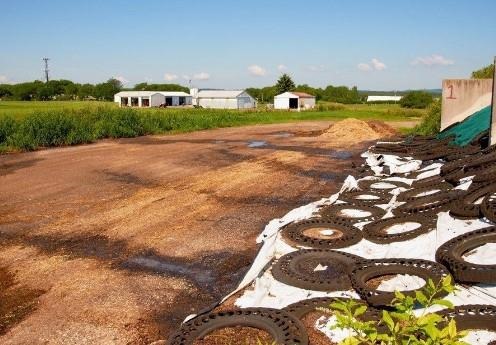By John Tyson
With corn silage harvest comes the concern of silage leachate. Silage leachate is always a concern no matter the type of silo used or the harvest management, although harvesting at the proper moisture content can help to minimize the amount of silage leachate produced. Where that leachate ultimately flows is the issue for the environment. Leachate represents a threat to surface water and groundwater quality due to its high biochemical oxygen demand (BOD), low pH, and high reducing potential.
Simply stated BOD is the amount of oxygen needed to break down the leachate. Silage leachate often has a BOD around 50,000 mg of oxygen per liter, while raw domestic sewage has about 500 mg per liter. So, silage leachate is about 100 times as strong as raw sewage. As little as one gallon of silage leachate can lower the oxygen content of 10,000 gallons of fresh water to a critical level for fish survival. If the silage leachate enters surface waters during periods when the flow is low and water temperatures are warm, the oxygen depletion is further aggravated, since the dilution potential is extremely limited and bacteria respiration rates are higher. The nutrient concentration of silage leachate, in terms of N, P, and K, is very similar to typical liquid dairy manure. The pH is typically in the 3.6 to 5.5 range which is another potential pollution problem and can lead to the characteristic vegetation burns around silos.
So, what can be done in terms of treatment/disposal? First, think about placement and preparation of the silo. Silos should be located away from open waterways and wells. Typical isolation distances range from 50 to 250 feet and preferably down slope of a well depending on geology, soil type, well type, and silo type. An unused piece of pasture by the stream may seem like a nice place for a bunker silo, but the potential for silage leachate to pollute that stream is extremely high. Proper selection and preparation of the site will also help the minimization, collection and/or treatment of the leachate. When siting silage piles chose a location that is at least five feet above the seasonal high-water table and on a slope of less than two percent. Divert clean water away from the site and layout the site so on-site runoff will move toward a common point for collection and/or treatment.
To limit the treatment, try to minimize the amount produced. Basically, this means ensiling at the proper moisture content. When harvested at a dry matter content of 30% or greater the flow of leachate is greatly reduced. Covering horizontal silos and piles also helps to reduce the prolonged flow of leachate.

Silage Leachate without proper containment
Even when silos and piles are properly located and leachate flow is minimized, there is still leachate to handle. There are several methods to handle leachate. Probably the most commonly used method is incorporation into a liquid manure system. Be very careful when mixing silage leachate with manure. Hydrogen sulfide and other poisonous gases are produced, and it should not be mixed in at all if the storage is covered or under the barn. The second option is land application to a crop field or grass filter strip. However, leachate must first be diluted with water if applied to a growing crop; typically, a 1-to-1 ratio will work. The leachate can also be directly applied to fields with a non-growing crop.
Treatment must be addressed on a case-by-case basis because each farm is different. Help is available through the NRCS, Conservation District, and Penn State Extension. The consequences of ignoring the problem will not make it go away, and improper handling of silage leachate can create environmental problems. Proper siting of silage storage facilities and piles, diversion of clean water away from site, harvesting at proper moisture contents, and covering bunkers, trenches and piles can all help to minimize leachate, but all leachate should be collected and treated appropriately.
Don't Ignore the Problem: it's not going to go away!
Source : psu.edu